Abstract
As the amount of sewage sludge (SS) is increasing worldwide, anaerobic digesters (ADP) are being distributed to reduce it and treat it in an environmentally friendly way. In Korea, 20 years have passed since the introduction of ADP, but the number of sewage treatment plants (STP) installed with ADP is only about 10% of the total STP. Accordingly, problems and improvements were examined through material flow analysis targeting STP, and the effect of introducing anaerobic digestion (AD) was analyzed as a way to solve them. As a result of the analysis, the amount of SS generated by the STP (SS-ADP + Co-ADP) installed and operated by an AD was 0.54 kg/m3, and the facility without it was 0.77 kg/m3, showing a reduction effect of about 31%. The SS reduction effect of the facility that only used SS-AD was found to be reduced by 21–24% TOE (Ton Of Equivalent))/day, which has the effect of reducing 794,867 kg-CO2/day of greenhouse gas. In terms of energy efficiency, Co-AD was 86% higher than SS-AD, and biogas production yield was 90% higher than that of SS-AD. Therefore, it is necessary to introduce Co-AD into STP in terms of reducing SS, energy production, and greenhouse gas reduction.
1. Introduction
Sewage sludge (SS) is generated in the process of treatment of wastewater including various organic substances; 80% is water and 20% contains total solids (TS) [1]. The amount of SS generated is expected to increase continuously because an expanded area of sewer and regulations on effluent is strengthened [2,3]. Composting SS is considered the best option due to its sustainability and integration into the circular bioeconomy concept [4]. However, it has a problem with circulation due to the fact that sludge is being produced all year round, whereas its application on land takes place once or twice a year. Moreover, it contains heavy metals and (DOM), which increase the leaching of heavy metals due to DOM [5,6]. In addition, as organic matter decomposes it emits greenhouse gas (GHG) [7] and odor [8]. Accordingly, there is a need for a method that can reduce and treat in an environmentally-friendly manner.
Recently, biomass is a renewable, and renewable material derived from biomass is recognized to create new value as a carbon-neutral material [9]. It is possible to reduce and process at the same time while obtaining additional energy by using biomass that requires cost in treatment such as SS and food waste [10]. Recently, in the new phase of reducing greenhouse gas, interest in carbon-neutral materials with a high organic matter content is increasing, and it is a subject of interest in terms of effectively using materials that are difficult to dispose of such as incineration and landfills [11]. Since sewage treatment plants (STP) are representative energy-consuming facilities [12], anaerobic digester plants (ADP) that produce energy have become an important and essential part of wastewater treatment plants (WWTP). Additionally, co-anaerobic digester plants (Co-ADP), in which two or more substrates are digested simultaneously, are being introduced.
Anaerobic digestion (AD) is generated by biogas and it can be used as fuel to generate heat and electricity at STP [13]. Moreover, AD can reduce the organic matter content of sludge by 40 and 50% [14] which leads to a significant reduction in the final sludge volume [15]. AD enhances the stabilization of sewage sludge and reduces pathogens and odor emissions.
Sludge processing accounts for 40–60% of the total operational costs [16]. Considering the cost of sludge disposal, it can be said that the contribution of ADP to STP is very large. Therefore, the ADP is playing a very positive role in the energy independence of STP and economical sludge treatment. Successful cases of Co-ADP of SS and biowaste were reported at WWTP in Denmark, Germany and Switzerland [17]. Recently, various studies have been conducted on methods such as introducing a pretreatment facility or mixing various biomass to increase the efficiency of AD [18,19], but there is a limit that the effect of the capacity of STP is not reviewed.
At the end of 1990, interest in SS in Korea became the subject of leachate and odor problems at landfills in the metropolitan area. Therefore, it was designated as organic sludge with an organic content of 40% or more, and direct landfilling was prohibited from 2003 [20]. In 2003, a notice was enacted to induce recycling for use in land improvement systems and landfills. After the ban on direct landfills, all SS was concentrated on ocean discharge, where the treatment cost was low and became a social problem. In order to convert to land treatment, policies focused on the diversification of treatment methods and expansion of treatment facilities. However, as the amount of SS generated increased and decreased due to the introduction of advanced treatment methods and phosphorus regulations, in 2010, a basic plan for energy independence of STP was established and a reduction project was introducing ADP [21].
Despite implementing energy independence for 10 years, the number of ADPs installed in Korea accounts for only 1% of all STP. In addition, there is currently no analysis on the SS reduction effect of ADP installed in STP. Similar studies in the past analyzed the effects of ADP for specific STP, and there is a limit in which the analysis was not performed. In order to examine the effect of introducing ADP, it is necessary to diagnose the current operating conditions of STP and the effects of ADP [22,23]. Therefore, in this paper, the effect of introducing ADP was analyzed based on the current status of STP nationwide in Korea, and a plan to expand the supply of ADP to STP was presented.
2. Materials and Methods
2.1. Sewage Treatment Facility Material Flow Analysis
To understand the operation status of STP in Korea, we made a material (SS) flow chart, which used sewage statistics [24] and some assumptions. Inflow was applied to sum the inflowing sewage from all STP (4281 places) and the wastewater (the sum of manure, livestock manure, leachate, and other treated water is applied). The total energy consumption of STP applied the sum of electricity consumption and self-energy consumption (solar power, biogas). The amount of SS generated in the STP was dewatered sludge. Since the amount of digested SS is not in statistics, 72.3% of VS/TS and 30.7% of digestion efficiency were applied [22]. As for the moisture content of the dewatered SS, 74.1%, which is the value obtained by dividing the total amount of water in the dewatered SS generated in an STP with an ADP of the sewage statistics by the amount of dewatered SS was applied.
2.2. Analysis of the Treatment Status of Sewage Sludge
The SS treatment method is not clear in the sewage statistics in Korea [21] and the treatment rate of the main treatment methods, such as cement co-processing, and solid refused fuel (SRF) cannot be confirmed. Therefore, it was prepared using the data on the current status of sludge disposal in 2020 in the Sewerage Information System [23].
The treatment methods of SS were classified by fuel (dry fuel, solidification fuel, carbonized fuel), landfill (landfill after solidification, landfill after drying, direct landfill), incineration (landfill after incineration, recycling (ash cement, etc.) after incineration), cement, soil use (composting, succulent soil, green soil, landfill cover material, solidified cover material, soil conditioner), earthworm breeding, and other (drying, etc.).
2.3. Effect of the Introduction of Anaerobic Digesters in a Sewage Treatment Facility
The reduction effect of the installation of an ADP was analyzed by the basic unit (SS-ton/sewer-m3) of SS by the capacity of STP for 33 STP (apply SS-AD). Compared to the larger the STP, the more it affects the characteristics of SS, so it is necessary to analyze by classifying the capacity of STP. Accordingly, the capacity of STP was divided into 0 to 100,000 tons and exceeding 100,000 tons, and the arithmetic average was applied using only the amount of SS generated from the on-site facility compared to the inflow sewage treatment amount. The reduction effect of the installation of ADP was compared with the source unit of SS generated by facilities with and without ADP by the capacity of STP. To analyze the effect of Co-AD on biogas production and energy efficiency (biogas m3/TOE), and the biogas production yield (Biogas m3/TSin-AD), it was classified into STP that SS-AD and Co-AD with food and livestock manure (Table 1).

Table 1.
Analyzed STP group by the capacity of STP. This table shows the number of analysis targets by capacity and the installation status and operation method of AD.
3. Results and Discussion
3.1. Sewage Treatment Facility Material Flow Analysis and Problems
Figure 1 shows the material flow of SS in the STP. As of 2020, a total of 4281 public STP are in operation in Korea, treating 21,240,609 tons/day of sewage and 349,093.3 tons/day of wastewater. The total amount of SS generated was 11,534 tons/d, the amount of SS generated by direct dewatering was 4755 tons/day, and the amount of dewatered sludge generated after anaerobic digestion was 6779 tons/day.
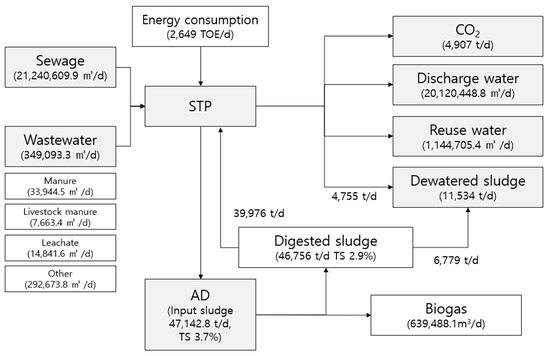
Figure 1.
SS flow in STP in Korea. Energy consumption refers to the total energy consumption of STP, and CO2 refers to energy consumption and the amount of CO2 emitted from STP. The amount of biogas refers to the amount of unrefined generation.
The basic unit of SS generation for STP without an AD was 0.68 kg/m3, and the basic unit for SS generation for facilities with an AD was 0.47 kg/m3, reducing the amount of SS generated by STP with anaerobic digesters by 31%. It is possible, and it is producing 366.6 m3/TSin-AD (ton) of biogas. The energy consumption of the STP is 2649 TOE/day, which is energy-consuming and emits a large amount of greenhouse gas (4,905,681 kg-CO2/day). Considering the amount of biogas produced through anaerobic digestion (639,488.1 m3/day) and heat (5875 kcal/m3) [24], it produces 375.5 TOE/day of energy and is a greenhouse with 794,867 kg-CO2/day (LPG(Liquefied Petroleum Gas) equivalent). It has the effect of reducing energy.
As such, the anaerobic digester has the function of reducing sewage sludge and producing energy [23], considering that 62 STP (mostly large-scale) with a sewage treatment capacity of 500 m3/day or more are in operation compared to 698 STP nationwide; it is practically difficult to introduce ADP in small-scale STP. As the amount of sludge generated in small-scale STP is low, it is impossible to install individual facilities, and a high cost is required for treatment. Therefore, it is necessary to expand the processing scale through intensive processing, such as transferring to a large-scale STP.
Figure 2 shows the amount of SS generated compared to the amount of sewage treatment from the late 1990s to the 2000s. The annual amount of SS generated in 1996 was 1.17 million tons but increased to 4.21 million tons in 2020. As of 2020, the amount of SS generated treating 1 m3 of sewage was 0.55 kg, and it can be seen that the source unit of SS has continuously increased from 0.35 kg/m3 in the 1990s. Although the amount of SS was increased due to the maintenance of STP in the 2002s, the amount of SS generated compared to the amount of sewage treatment increased rapidly.
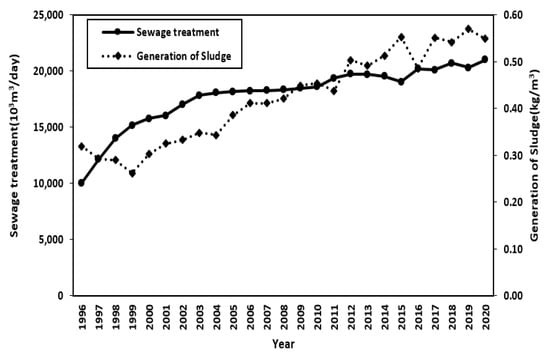
Figure 2.
Basic unit of sewage sludge per sewage treatment. The left is the amount of sewage inflow from the STP, and the right is the amount of sewage sludge per sewage treatment.
Therefore, considering the increase in the sewage supply rate, the classification of sewage pipelines and the introduction of disposers, and the increase in the amount of wastewater, the amount of SS generated is expected to increase further, so it is necessary to reduce the amount of SS and improve the treatment capacity of SS. However, considering that the SS treatment facility is an NYMBY (Not In My Back Yard), efforts to reduce the amount of SS should be first.
Figure 3 shows the usage status of biogas produced by STP for the period from 2017 to 2020. Biogas production was increasing from 594,478 m3/day to 640,308.1 m3/day. As for the method of use, the number of sales, power generation, and others decreased, and the rate of self-utilization increased. Biogas power generation was known to have the highest economic feasibility, but it seems that the use of biogas power generation has decreased due to difficulties in the operation and maintenance of the biogas generator [25]. The reason for the increase in self-utilization may be that the use of gas in the form of gas is the most economical, but it is also considered to be the cause of the lack of suitable sources of demand.
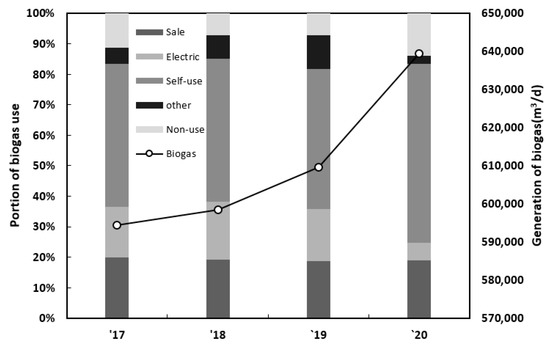
Figure 3.
Status of biogas production and use in STP. The bar graph shows the change in the use rate of biogas. The line represents the change in biogas production.
The amount of surplus gas incinerated without being used is 89,308.8 m3/day, which accounts for 14.0% of the total biogas production. This means that even with an increase in energy production capacity, there are insufficient measures available [26]. Assuming that the methane content is 60% [27], it means that 53,717 m3/day of biomethane is wasted. Therefore, in order to promote the utilization of biogas, it seems necessary to conduct research related to the social foundation for the efficient use of biogas, which is the most economical, in the form of gas, and institutional support related to the commercialization of biogas.
Figure 4 shows the amount of treatment by sewage sludge treatment method in 2015 and 2020. It can be seen that the ratio of fuel conversion, landfill, and incineration decreased, and the ratio of cement use and other treatment methods increased. In the past, dry sludge could be finally treated at thermal power plants, but recently, each power plant is reducing the use of SS-fuel by reducing the REC (renewable energy certificate) for Bio-SRF and implementing the ‘Regulation of Coal Power Plant’ to reduce fine dust and carbon emissions. However, it seems that the use of fueling has decreased significantly because it has been used as a fuel and replaced material in the cement industry. The main reason for the increase in other methods is considered to be the increase in the amount of SS drying facilities consigned to private SS drying facilities due to the decrease in the amount of fuel used. While the amount of SS generated is continuously increasing, it is expected that the use of SRF and cement will become difficult due to the saturation of the landfill, the difficulty of expanding and additional installation of incineration facilities, and environmental problems, so an eco-friendly treatment method is needed.
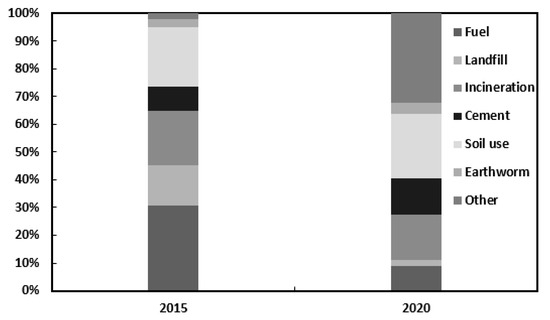
Figure 4.
Changes in main sewage sludge treatment methods. The bar graph means the ratio of sewage sludge by treatment method.
3.2. Sewage Sludge Digestion Facility Installation and Reduction Effect
Figure 5 shows the result comparing the degree of sludge reduction to the presence or absence of ADP for each facility size of STP in operation in Korea. The amount of SS generated by the facilities with ADP was 0.54 kg/m3, and the facilities without it were 0.77 kg/m3. By facility size, for STP with a capacity of fewer than 100,000 tons, 0.61 kg/m3 where a digester was installed, 0.77 kg/m3 where ADP was not installed, and 0.49 kg/m3 for STP with a capacity of 100,000 tons or more. It is 0.64 kg/m3, which is 21~24% reduced by facility size, indicating that anaerobic digestion plays a high role in reducing SS. These results show a numerical value similar to the arithmetic calculated at 22%.
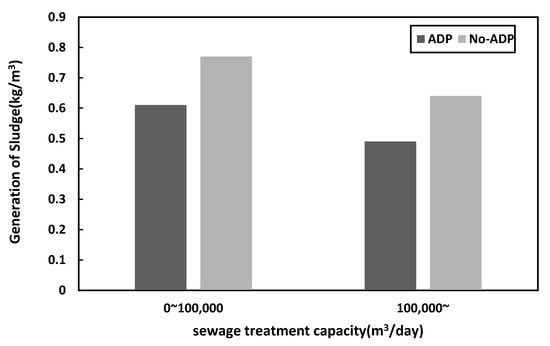
Figure 5.
The amount of SS generated compared to the unit throughput capacity according to whether or not an ADP is installed. The dark bar indicates the basic unit of SS generation of STP that performs only SS-ADP, and the light bar indicates the basic unit of SS generation in STP that does not have an ADP.
It is known that government subsidies are necessary to maintain the profitability of anaerobic digestion [28]. Considering that the treatment capacity of the STP is 100,000 tons/d and the amount of sludge input to the anaerobic digester is 400 m3/d, the benefit/cost = 1 [29]. It is economical to operate an ADP from STP of 100,000 tons/d or more, and STP below 100,000 tons will require expanded government subsidies or solubilization technology such as thermal hydrolysis for facility installation and operation [30].
Figure 6 shows the energy efficiency and biogas production yield by AD type (SS-AD and Co-AD). The energy efficiency of SS-AD was 0.79 m3/TOE, and the energy efficiency of Co-AD was 1.47 m3/TOE, which was 86% higher than that of SS-AD. The yield of biogas production was 3.00 m3/TSin-kg for SS-AD and 5.71 m3/TSin-kg for Co-AD, which was 90% higher than that of SS-AD. This means that when AD is carried out in an STP, Co-AD is more advantageous than SS-AD, and it is consistent with existing research cases that existing Co-AD is superior to SS-AD [31].
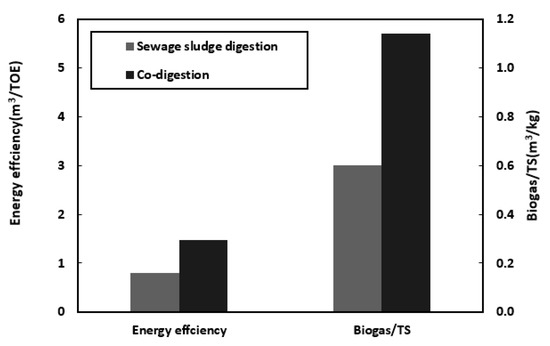
Figure 6.
Energy efficiency and biogas production yield of only SS-AD and Co-AD. The bright bar is a facility that AD only SS, and the black bar is a facility that AD food and livestock manure together.
4. Conclusions
STP is a representative that consumes large amounts of energy and emits greenhouse gases and discharges SS as waste. Accordingly, the effect of AD was analyzed through the current status analysis for all STP in Korea, and a plan to expand the supply of AD was presented.
- Effect of AD
As a result of comparing the amount of SS generated at the facility that installed ADP and without ATP, it was found that there was a reduction effect of about 21–24% depending on the capacity of the STP. It can be seen that the reduction rate of SS after AD is generally low compared to 40–50%. This seems to mean that the ADP of Korean STP is not properly operated.
In Korea, AD reduces SS and reduces GHG by 794,867 kg-CO2/day. This means contributing to the sustainability of STP. However, it is not a review of the level of LCA analysis, and it is difficult to view it as a net greenhouse gas reduction effect because it does not include greenhouse gases emitted into the atmosphere during the sewage treatment process. In terms of energy efficiency, Co-AD was 86% higher than SS-AD and the biogas production yield was 90% higher than SS-AD.
Therefore, it is considered that the introduction of AD into STP is reasonable in terms of SS reduction, energy production, and GHG.
- 2.
- Promotion of the installation of Co-AD
As of ‘20, 62 ADPs were installed and operated in STP, and the rest were dehydrated and treated without decomposition of organic matter.
However, as can be seen from the conclusion, when the disposal capacity of STP is high, the reduction rate of sewage sludge is high and when the AD is operated in the form of Co-AD, the biogas production efficiency and energy efficiency is high. Considering this, two methods can be considered as a method for introducing an anaerobic digester in an STP.
Firstly, promoting an intensive facility that collects and treats SS from 2~3 STP, or installing a sewer sludge treatment facility (SSTF) in one metropolitan city to collect and treat all sludge in the area. It is required to establish a system for estimating the size of each region, installing an SSTF, and transporting concentrated sludge by vehicle or pipeline.
Secondly, integrated biogas should be encouraged in terms of energy independence and carbon reduction of STP. To this end, it is necessary to organize the concept of Co-AD, prepare relevant guidelines and support measures, and promote installation by giving more incentives when installing Co-AD to facilitate the installation of the facility. However, we will establish and optimize the monitoring system for the operation of the AD and foster professional human resources and professional operating systems through continuous education.
Author Contributions
Conceptualization, C.P. and D.K.; methodology, C.P.; writing—original draft preparation, D.K.; writing—review and editing, D.K.; supervision, C.P. All authors have read and agreed to the published version of the manuscript.
Funding
This research was supported by the Korea Ministry of Environment (MOE) as Waste To Energy-Recycling Human Resource Development Project, grant number 2020-0300.
Institutional Review Board Statement
Not applicable.
Informed Consent Statement
Not applicable.
Data Availability Statement
Not applicable.
Conflicts of Interest
The authors declare no conflict of interest.
References
- Song, H.W.; Han, S.K.; Kim, C.G.; Shin, H.G. A Study on the Viscosity Characteristics of Dewatered Sewage Sludge according to Thermal Hydrolysis Reaction. J. Korea Org. Resour. Recycl. Assoc. 2014, 22, 27–34. [Google Scholar]
- Werther, J.; Ogada, T. Sewage sludge combustion. Prog. Energy Combust. Sci. 1999, 25, 55–116. [Google Scholar] [CrossRef]
- Peccia, J.; Westerhoff, P. We Should Expect More out of Our Sewage Sludge Jordan Peccia and Paul Westerhoff. Environ. Sci. Technol. 2015, 49, 8271–8276. [Google Scholar] [CrossRef] [PubMed]
- Razza, F.; D’Avino, L.; L’Abate, G.; Lazzeri, L. The role of compost in bio-waste management and circular economy. In Designing Sustainable Technologies, Products and Policies; Benetto, E., Gericke, K., Guiton, M., Eds.; Springer: Cham, Switzerland, 2018; pp. 133–143. [Google Scholar] [CrossRef]
- Fytili, D.; Zabaniotou, A. Utilization of sewage sludge in EU application of old and new methods—A review. Renew. Sustain. Energy Rev. 2008, 12, 116–140. [Google Scholar] [CrossRef]
- Fang, W.; Wei, Y.; Liu, J. Comparative characterization of sewage sludge compost and soil: Heavy metal leaching characteristics. J. Hazard. Mater. 2016, 310, 1–10. [Google Scholar] [CrossRef] [PubMed]
- Dume, B.; Hanč, A.; Švehla, P.; Chane, A.; Nigussie, A. Carbon Dioxide and Methane Emissions during the Composting and Vermicomposting of Sewage Sludge under the Effect of Different Proportions of Straw Pellets. Environ. Sci. Proc. 2021, 8, 7. [Google Scholar] [CrossRef]
- Andersson, M.J.E.; Andersson, L.; Bende, M.; Millqvist, E.; Nordin, S. The Idiopathic Environmental Intolerance Symptom Inventory: Development, Evaluation, and Application. J. Occup. Environ. Med. 2009, 51, 838–847. [Google Scholar] [CrossRef] [PubMed]
- Krzyzanowski, F., Jr.; de Souza Lauretto, M.; Nardocci, A.C.; Sato, M.I.Z.; Razzolini, M.T.P. Assessing the probability of infec-tion by Salmonella due to sewage sludge use in agriculture under several exposure scenarios for crops and soil ingestion. Sci. Total Environ. 2016, 568, 66–74. [Google Scholar] [CrossRef]
- Smoliński, A.; Karwot, J.; Bondaruk, J.; Bąk, A. The Bioconversion of Sewage Sludge to Bio-Fuel: The Environmental and Economic Benefits. Materials 2019, 12, 2417. [Google Scholar] [CrossRef]
- Wei, Y.; Van Houten, R.T.; Borger, A.R.; Eikelboom, D.H.; Fan, Y. Minimization of excess sludge production for biological wastewater treatment. Water Res. 2003, 37, 4453–4467. [Google Scholar] [CrossRef]
- Cho, I.H.; Ko, I.B.; Kim, J.T. Technology Trend on the Increase of Biogas Production and Sludge Reduction in Wastewater Treatment Plants: Sludge Pre-treatment Techniques. Korean Chem. Eng. Res. 2014, 52, 413–424. [Google Scholar] [CrossRef][Green Version]
- Cho, E.L.; Han, D.H.; Ha, J.S. Energy Efficiency Evaluation of Publicly Owned Wastewater Utilities. J. Environ. Policy 2012, 11, 85–105. [Google Scholar]
- Pettpain, F. Municipal Sludge Digestion Attracts Interest as Energy Prices Rise. In Water World Magazine; 2006; Volume 21, Available online: https://www.waterworld.com/wastewater/article/16200704/municipal-sludge-digestion-attracts-interest-as-energy-prices-rise (accessed on 1 June 2022).
- Hanum, F.; Yuan, L.C.; Kamahara, H.; Aziz, H.A.; Atsuta, Y.; Yamada, T.; Daimon, H. Treatment of Sewage Sludge Using Anaerobic Digestion in Malaysia: Current State and Challenges. Front. Energy Res. 2019, 7, 19. [Google Scholar] [CrossRef]
- Guo, W.-Q.; Yang, S.-S.; Xiang, W.-S.; Wang, X.-J.; Ren, N.-Q. Minimization of excess sludge production by in-situ activated sludge treatment processes—A comprehensive review. Biotechnol. Adv. 2013, 31, 1386–1396. [Google Scholar] [CrossRef] [PubMed]
- Braun, R.; Wellinger, A. Potential of Co-Digestion; IEA Bioenergy: Vienna, Austria, 2009. [Google Scholar]
- Khanh Nguyen, V.; Kumar Chaudhary, D.; Hari Dahal, R.; Hoang Trinh, N.; Kim, J.; Chang, S.W.; Hong, Y.; Duc La, D.; Nguyen, X.C.; Hao Ngo, H.; et al. Review on pretreatment techniques to improve anaerobic digestion of sewage sludge. Fuel 2021, 285, 119105. [Google Scholar] [CrossRef]
- Van, D.P.; Fujiwara, T.; Tho, B.L.; Toan, P.P.S.; Minh, G.H. A review of anaerobic digestion systems for biodegradable waste: Configurations, operating parameters, and current trends. Environ. Eng. Res. 2020, 25, 1–17. [Google Scholar] [CrossRef]
- Lee, C.H.; Ahn, K.H.; Song, S.K. Dewatering Characteristics for Physicochemical Properties with Sewage Sludge. KSBB J. 2010, 25, 41–46. [Google Scholar]
- Ministry of Environment. Statistics of Sewerage; Ministry of Environment: Sejong City, Korea, 2020. [Google Scholar]
- Kim, D.W. Determination of Optimal Operating Conditions by Analysis of Operation Status of Anaerobic Digestion Tanks in Korea. Master’s Thesis, Seoul National University of Science and Technology, Nowon, Seoul, Korea, 2020. [Google Scholar]
- Sewerage Information System. Available online: https://www.hasudoinfo.or.kr (accessed on 1 March 2022).
- Lee, D.J.; Lee, S.Y.; Kang, J.G.; Lee, S.S.; Kim, Y.R.; Hwang, D.G.; Kim, K.H.; Chung, J. Effects of Food Waste Leachate Addition on Organic Degradation Efficiency of Sewage Sludge Anaerobic Digestion. J. Korea Soc. Waste Manag. 2014, 31, 763–771. [Google Scholar] [CrossRef]
- Lee, P.-E.; Lee, W.-B.; Moon, H.; Kwon, J.; Namkung, H.; Lee, W.; Yoo, M.; Lee, D.-J. A Feasibility Study on Effect of Food Waste Leachate Additions in the Full-Scale Waste Leachate Treatment Facility after the African Swine Fever Outbreak in South Korea. Energies 2021, 14, 8045. [Google Scholar] [CrossRef]
- Jo, Y.B.; Oh, Y.G.; Shin, D.C.; Park, C.H. Distribution of Total Organic Carbon and Correlations between Organic Matters of Sewage Treatment Plants. J. Korean Soc. Environ. Anal. 2014, 17, 207–214. [Google Scholar]
- Kim, G.J.; Kim, L.H. Optimal Operation of Gas Engine for Biogas Plant in Sewage Treatment Plant. J. Energy Eng. 2019, 28, 18–35. [Google Scholar]
- Park, K.H.; Lee, H.S.; Ha, J.S.; Kim, K.T.; Lim, C.S. Study on Energy Independence Plan and Economic Effects for Sewage Treatment Plant. J. Korean Soc. Water Environ. 2021, 37, 128–136. [Google Scholar]
- Lim, Y.K.; Lee, J.M.; Jung, C.S. The Status of Biogas as Renewable Energy. Korean Soc. Ind. Eng. Chem. 2012, 23, 125–130. [Google Scholar]
- Lisowyj, M.; Wright, M.M. A review of biogas and an assessment of its economic impact and future role as a renewable energy source. Rev. Chem. Eng. 2020, 36, 401–421. [Google Scholar] [CrossRef]
- Lee, D.; Lee, S.; Kwon, Y.; Cho, Y.; Bae, J. A Study on Environmental and Economic Analysis for Each Treatment of Sewage Sludge(II)-Results of Economic Analysis. J. Korea Org. Resour. Recycl. Assoc. 2016, 24, 15–29. [Google Scholar] [CrossRef][Green Version]
Publisher’s Note: MDPI stays neutral with regard to jurisdictional claims in published maps and institutional affiliations. |
© 2022 by the authors. Licensee MDPI, Basel, Switzerland. This article is an open access article distributed under the terms and conditions of the Creative Commons Attribution (CC BY) license (https://creativecommons.org/licenses/by/4.0/).